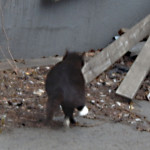
As Barb Zibrik pulls up into the driveway of a small stucco house with an overgrown yard plunked among the small businesses, an open trailer containing a few branches comes to life.
Four feline heads — two gray, one black, one orange — pop up to see who’s arrived. Another cat, this one black, watches warily from beside the house.
These cats and dozens more belong to no one. Some of them probably had an owner at one time, but no more. Now, no one can get close enough to touch them. No one can tame them.
And without Zibrik’s intervention, they would reproduce into the hundreds.
As it is, the executive director of the Kamloops and District Humane Society has trapped 102 cats from the area in the past two years. They’ve been spayed or neutered, vaccinated and had one ear snipped so they can be identified from a distance. The area isn’t being identified because there are people who would go there looking for the cats for all the wrong reasons.
There’s no getting close enough to read a tattoo inside an ear. These cats bolt as soon as humans get within their comfort zone.
Many of the business owners and residents of the area like the cats enough to feed them. Feeding, however, isn’t enough if the cats aren’t spayed or neutered. There are also those who don’t like cats or don’t want them around. Zibrik has met people with all views of this feral colony.

On April 19, she released three more young females that she had trapped and taken in for spaying and vaccinating. All were born last year, and have likely already had at least one litter each. It doesn’t take long for cats to reproduce and Zibrik tries to get them as young as possible to keep the numbers down.
She figures she has to catch at least 20 more cats to keep the colony numbers in check.
She takes the towel-covered carriers and sets them on the ground. She removes the coverings so the cats can see they’re back on familiar turf. One is black with white paws and ruff, another is has long white hair with brown markings and the third appears to have some lynx-point in it, with big blue Siamese eyes.
One by one, the wire carrier doors open. Each young cat hesitates for a moment, then scampers out and disappears around the house or into the nearby piles of scrap wood.
Zibrik puts some canned food on the ground, knowing the three she just released won’t be enticed back that quickly. She loads the carriers into her SUV, then sits inside and waits.
Within a couple of minutes, five other cats have come around — a black one, two greys, a tabby and an orange.
“I always stay for a while to see who shows up,” she said.

She traces the colony back to a call she got two years ago from someone who lived in a nearby four-plex who couldn’t keep her cats. There’s an apartment across the street that allows pets; Zibrik believes some people abandon their felines when they move elsewhere — in many cases, probably because their new location won’t allow animals.
With three more cats off her list, she plans on returning in a few days to trap again. She has spoken to many of the surrounding property owners, so she knows who she can count on to help keep the cats fed. But trapping is her job alone and it’s a job she will continue until all of the colony cats have that telltale tipped ear.
“There’s a lot more to be done,” she said.
